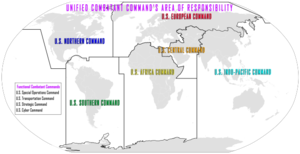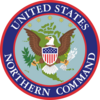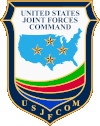Unified Combatant Command
A Unified Combatant Command ( UCC , German United Combat Command ) is composed of several units of two or more branches of the armed forces of the United States and has a wide-ranging and permanent mission. They are divided according to their Areas Of Responsibility (dt. Military responsibility and competence ) in regional and functional command areas and were in the course of military reform of 1986 established organization. There have been eleven Unified Combatant Commands since August 2019.
history
The United States established the first regional commandos with the most profound reform of the US military since 1947 , the Goldwater-Nichols Act in 1986. The introduction of commanders responsible to the Secretary of Defense to conduct military operations in their geographic jurisdiction was intended to alleviate the excessive rivalries between the armed forces. Her official title was Commander-in-Chief until 2002 with the corresponding regional suffix.
Since September 11, 2001 , the importance of the African continent for the United States has increased steadily for a variety of reasons. For this reason, President George W. Bush announced the establishment of a regional command for Africa ( US Africa Command ) that would be operational by 2008 .
The US Joint Forces Command was dissolved on August 31, 2011.
Chain of command and mission
The chain of command of the US armed forces runs administratively from the President via the Secretary of Defense ( National Command Authority , NCA) to the Joint Chiefs of Staff (JCS). The operational chain of command, however, runs from the President via the Defense Minister directly to the commanders of the individual Unified Combatant Commands .
The chairman of the Joint Chiefs of Staff can communicate with the commanders of the Unified Combatant Commands , but has no operational authority over the troops.
The armed forces have parallel command structures; their respective regional commands are integrated into the central UCCs.
The geographically oriented UCCs are not exclusively responsible for the supraregional execution of military orders from the Ministry of Defense, but are also involved in the everyday security and humanitarian business of the United States. As a result, the Pacific Command is often involved in rescue and supply missions after floods and earthquakes, while the Southern Command, in cooperation with the State Department , sent its own baseball team on an encounter tour through Central America in March 2009. In contrast, the functional UCCs primarily pursue conceptual goals, especially in the areas of logistics and strategy.
Regional commands
| The US Northern Command (NORTHCOM) is responsible for North America and the military and civil authorities in home defense at all federal levels in the United States.
NORTHCOM headquarters is based at Peterson Air Force Base in Colorado Springs , Colorado and is under the command of General Terrence J. O'Shaughnessy (USAF), who is also in command of the North American Aerospace Defense Command (NORAD) . |
|
| The US Indo-Pacific Command (USINDOPACOM) is the regional command responsible for all US troops in the Pacific and Indian Oceans . In north-south expansion, the area of responsibility extends from the Arctic to the Antarctic , including the US state of Hawaii and the troops in Alaska .
The headquarters of USINDOPACOM is on the US Marine Corps base Camp HM Smith on the island of Oahu (Hawaii) and is under the leadership of Admiral Philip S. Davidson ( USN ). |
|
| The US Southern Command (SOUTHCOM) is responsible for Latin America and is responsible for the coordination and management of all United States military operations in South and Central America and the Caribbean .
SOUTHCOM is headquartered in Miami , Florida and under the direction of Admiral Kurt W. Tidd ( USN ). |
|
| The US Central Command (CENTCOM) is the regional command responsible for the Middle East , Egypt and Central Asia . Until the establishment of the US Africa Command, the East African region from Sudan up to and including Somalia and Kenya belonged to his area of responsibility. The command was responsible for deploying and coordinating the US military and US-led coalition forces during numerous operations, including Operations Desert Storm and Desert Shield and Operation Iraqi Freedom .
The headquarters of CENTCOM is stationed at MacDill Air Force Base near Tampa ( Florida ) and is under the command of General Joseph L. Votel ( USA ). |
|
| The US European Command (EUCOM) is responsible for all military actions by the United States in Europe , Russia , the countries of the Caucasus and Turkey . Until 2008, EUCOM was also responsible for most of Africa . The command was responsible for the US military presence during numerous operations, including Operation Enduring Freedom , Operation Joint Guardian JTF Falcon ( KFOR presence in Kosovo), Operation Allied Forces JTF Noble Anvil (the air operations at the beginning of the Kosovo War) and the Operation Restore Hope (supporting US security efforts in Somalia).
The headquarters of EUCOM is stationed in the Patch Barracks in Stuttgart (Germany) and is under the leadership of General Tod Wolters ( USA ), who also holds the post of Supreme Allied Commander Europe (SACEUR) within the NATO structures . |
|
| The US Africa Command (AFRICOM) is the regional command responsible for the African continent (excluding Egypt ). It was set up from October 2007 and was operational in October 2008.
The headquarters, which is to be set up on the African continent, has so far been stationed in the Kelley Barracks in Stuttgart (Germany) and is led by General Thomas D. Waldhauser ( USMC ). |
|
| The original US Space Command (USSPACECOM) was established in 1985 and was the forerunner of today's United States Strategic Command (USSTRATCOM) until 2002 . In 2019 it was reorganized as an independent command. The headquarters are on Peterson Air Force Base , Colorado . |
Functional commands
| The US Special Operations Command (SOCOM) is the responsible cross-armed command facility for all US special forces in the US Army , US Air Force , US Navy and US Marine Corps . It carries out missions worldwide - also independently of the regional commandos - (military counter-terrorism and support for intelligence operations) and since the Nunn-Cohen Amendment came into force in 1987, it has had its own budget, which makes it de facto a separate armed forces because it is the only network command can independently plan, train, equip and deploy his troops independently of a branch of the armed forces, the civilian state secretaries in the Ministry of Defense or the United Chiefs of Staff.
The headquarters are located at MacDill Air Force Base in Florida and are led by General Raymond A. Thomas (USAR). |
|
| The US Strategic Command (STRATCOM) is the functional command responsible for the control of nuclear weapons of the US armed forces as well as for space activities (e.g. also space weapons ) and the National Missile Defense .
STRATCOM's headquarters are located at Offutt Air Force Base in Nebraska and are led by General John E. Hyten (USAF). |
|
| The US Transportation Command (TRANSCOM) is responsible for ensuring the worldwide military mobility of the US armed forces.
The headquarters are located at Scott Air Force Base , Illinois and are under the command of General Darren W. McDew (USAF). |
|
| The United States Cyber Command (USCYBERCOM) is responsible for electronic warfare, cyber operations and Internet security.
The headquarters are located in Fort Meade , Maryland and are under the command of General Paul M. Nakasone (US Army). |
Former commands
| The US Joint Forces Command (JFCOM) had mixed competencies and existed from 1999 to 2011. It was the regional command responsible for the protection of the sea routes in the Atlantic Ocean and the successor to the United States Atlantic Command. As a functional command, it was also responsible as a think tank for the further development of the combined struggle of the armed forces ( transformation ) and the training of the US armed forces. On August 9, 2010, US Secretary of Defense Robert Gates announced that the JFCOM would be dissolved due to austerity constraints within a year and the tasks would be transferred to the Joint Staff . It was officially dissolved on August 31, 2011. |
References
Web links
Individual evidence
- ^ Jens Hohmann: North America - USA - Unified Combatant Command / Vereinigte Kampfkommando ( Memento from October 18, 2013 in the Internet Archive ) , GlobalDefence.net, September 30, 2008
- ↑ USA want to wage anti-terrorist fight from Stuttgart ( SPIEGEL Online, February 7, 2007)
- ↑ a b Website of the US Joint Forces Command ( Memento of February 2, 2001 in the Internet Archive )
- ↑ Flores, Gino: Southern Command Baseball Team Embarks on Friendship Tour to Latin America , March 24, 2009. Accessed March 24, 2009.
- ↑ Tom Clancy's interview with Gen. (ret.) Henry H. Shelton , page 92, Tom Clancy, John Gresham: Special Forces - The US Army special forces. Heyne, Munich 2002 ISBN 3-453-86912-5
- ↑ Gates to close JFCOM, cut gen. Officer billets ( Memento of March 15, 2011 in the Internet Archive ) (MarineCorpsTimes.com of August 10, 2010; English)













